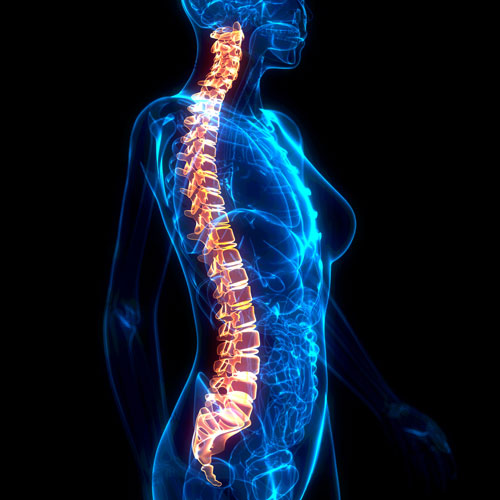What Are My Options for Scoliosis Pain Relief?

If you’ve been diagnosed with scoliosis, it’s hard to predict what symptoms you might develop over time. This is because there are so many factors that can influence how an abnormal spine curvature like scoliosis affects your ability to cope with issues like pain, muscle imbalances, stiffness, and more. The severity of the curve, your overall mental health, and access to holistic care can all play a role in what symptoms you may experience.
Regardless, if you, or a loved one, is experiencing pain from scoliosis it’s time to find a solution that works for you. There are a wide range of treatment options for helping you manage your pain, ranging from more holistic options like chiropractic care to more invasive options like injections. In general, it is recommended that you try more conservative approaches for pain relief before exploring more invasive options that can come with pesky side effects. Today, we will dive into all your potential options so that you can make an informed decision.
What is Causing My Pain?
Let’s dive into the basics of pain and how scoliosis can cause pain and affect your ability to cope with pain.
The Purpose of Pain
Primarily, when we experience pain it is caused by an external stimulus, such as an impactful injury, pricks, pokes, excessive pressure, changes in temperature (burning heat or freezing cold), and more. These stimuli directly activate sensory receptors in our body called nociceptors. These receptors then relay a message to the spinal cord and brain that pain is being generated and something needs to be done. This pain information is essential for keeping us safe by protecting an injured area or quickly pulling away from a dangerous situation (i.e. pulling a hand from a hot flame).
The Problem with Pain
Pain plays an essential role in our existence. However, it can also become “rogue” and become exasperating as well. This is because pain can also be generated when there are internal body imbalances as well. This type of pain can be extremely hard to pinpoint since there is no outside stimulus to recognize. Ultimately, pain without a clear stimulus is usually affecting local nerves and other sensitive internal tissues. Unfortunately, it can come with a lot of stigma because of the risk of chronicity, reports of seemingly vague symptoms, and more. This type of pain is best addressed with holistic care that helps restore overall balance in the body, particularly the spine.
Scoliosis and Pain
Scoliosis can lead to both the direct activation of the pain system and more vague underlying symptoms due to spinal misalignments that cause nerve dysfunction and poor flow. The most common underlying issues that lead to scoliosis pain include the following:
- Misalignment of the…
- Hips
- Pelvis
- Shoulder blades
- Lower back (lumbar spine)
- Neck (cervical spine)
- Mid-back/upper back (thoracic spine)
- A combination of one or more of the areas listed above (and more!)
- Poor posture
- Muscle imbalances
- Poor movement biomechanics
Ultimately, these issues can all lead to tissue damage and chronic pain due to:
- Local or global inflammation
- Joint strain/sprain of the spine, hips, and beyond
- Nerve compression
- Nerve stretching
- Muscle tension and stiffness
- Muscle strain
- Spine or joint degeneration
- Muscle fatigue
- And more…
When to Seek Care for Scoliosis Pain
When living with scoliosis, you don’t have to settle for suffering in pain. Any of the following reasons are a great indicator for finding appropriate care to get the pain relief you deserve.
- Preventative care. Preventing a curvature progression and keeping the spine as healthy as possible is always better than waiting until symptoms appear. Approaching scoliosis care preventatively typically involves management that addresses both your spine health and lifestyle all in one carefully designed plan.
- Pain that doesn’t resolve with home treatment. If you’ve been trying home remedies for a week or two (such as rest, stretching, or pain modalities) and your pain symptoms aren’t improving, or even getting worse, it’s time to find care. Staying on top of your pain before it becomes severe is imperative to minimize unnecessary long-term suffering.
- Chronic pain. If your pain has been going on for more than 6 weeks, it is now considered chronic. Chronic pain changes the way the body and mind cope with pain because of changes in neural health and sensitivity. Seeking medical care with a professional that understands the nuances of chronic pain can be a game changer.
- Your symptoms are having negative effects on your mood, mental health, and quality of life. If your pain is making it hard to participate in daily activities, making it hard to focus, or any other mood related dysfunction, it’s time to get help.
- Neurological symptoms. Since scoliosis mostly affects the spine, it’s important to pay close attention to the onset of any neurological symptoms. These indicate increased strain and stress on the nervous system that needs to be addressed as soon as possible. If you experience symptoms of shooting pain, extreme muscle weakness, changes in bowel or bladder control, tingling, or numbness- it’s time to talk to your doctor or chiropractor immediately.
Pain Relieving Treatment Options for Scoliosis
Thankfully, there are a ton of great options for addressing your pain from scoliosis. All you need to do is find the option that yields the best results for your specific needs. Each option has its pros and cons that you can weigh personally to get the best possible results.
- Chiropractic care. Chiropractors are spine experts, making them one of the top choices for treating scoliosis. This is especially true if you find a chiropractor that specializes specifically in scoliosis, like the team at the Bay Area Scoliosis Center in California. Chiropractors can diagnose scoliosis with the use of an x-ray, complete an in depth assessment, and provide high quality treatment to promote optimal spine alignment via adjustments, exercise, bracing, education, and beyond. The chiropractors at Bay Area Scoliosis Center specialize in Chiropractic Biophysics (CBP), the most research based chiropractic technique on the planet.
- Physiotherapeutic Scoliosis Specific Exercise (PSSE) can be one of the most powerful tools in specialized scoliosis care. Finding a practitioner that understands the three dimensional aspects of scoliotic deformity is crucial in getting a great outcome. Scoliosis is complicated, and not all physical therapists or chiropractors are trained in specialized methods of correction. Some of the most studied and trusted methods of PSSE, are ScoliBalance® and The Schroth Method.
- Physical Therapy. A physical therapist is a movement specialist for keeping you actively participating in your daily activities despite scoliosis symptoms. They can assess your spine health and provide treatment recommendations for optimizing biomechanics. This is done with manual therapy, exercise, and more.
- Bracing. Use of a brace is a time tested option for supporting the spine to minimize the risk of curvature progression. A specialized orthopedic doctor or chiropractor can get you properly fitted in a brace. Some chiropractors specialize in dynamic bracing that can help encourage better movement mechanics and even reduce spine curvature. For example, the Bay Area Scoliosis Center specializes in fitting patients with the highly recommended ScoliBrace®.
- Regular exercise. Scoliosis friendly exercise options like low impact exercise, core strength, yoga, pilates, swimming, and stretching can help your spine feel great. The spine is made to move and thrives when it gets adequate blood flow and muscle activation with exercise. Talk to your choice of trusted healthcare professional to determine what will work best for you.
- Acupuncture or Massage Therapy. The focus with acupuncture or professional massage is to help the body better cope with pain while promoting better muscle balance. They can provide great short term relief for certain people and are potentially worth a try.
- Medication. This can range from over the counter pain relieving options to medications prescribed by your general doctor or orthopedic doctor. Outside of pain relief, certain medications can also help with inflammation, nerve pain, muscle spasms, and more. While these are very common and great for short term relief, they don’t address any underlying issues and can come with nasty side effects and even long-term codependence.
- Injections. The injection of corticosteroids to relieve local pain and inflammation is common with moderate to severe spine pain caused by scoliosis. Once again, this can provide great short term relief but is invasive and negative side effects on tissue health need to be reviewed.
- Peripheral nerve stimulation. If pain is moderate to severe and chronic, a nerve stimulator can be inserted into the spinal cord (or nerve roots) itself. This can help or modify debilitating pain signals when the stimulator is on. Initially, you would most likely trial the use of an external stimulator unit to see if it is effective for managing your pain or not.
- Surgery. While surgery should never be recommended solely for pain management, sometimes the correction of a severe curvature with surgery can also reduce pain. In general, complete relief of pain isn’t expected- but your symptoms may improve and become more manageable as your spine stabilizes in more severe cases.
Choosing the Best Option for Living with Less Pain
Ultimately, what treatment works best for you will come down to your unique needs and preferences. As mentioned earlier, starting with the most holistic and conservative option is always preferable. When reviewing all of the options listed above, it should be clear that the most comprehensive option is chiropractic care.
If you are looking for a chiropractor that specializes in scoliosis care and pain management in Alameda and Oakland, CA your go to clinic is the Bay Area Scoliosis Center. Dr. Cynthia Boyd and her team are dedicated to providing you high quality care for all of your scoliosis needs. Get in touch with our office today.


